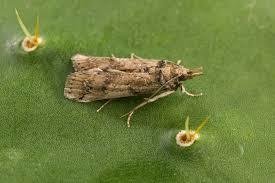THe Cactus Moth
Cactoblastis cactorum

Lifecycle
- Full-grown moths emerge from their cocoon near a cactus
-
Moths mate the next day
-
Moths start to lay eggs that night
-
Eggs hatch
-
Larvae gather together and penetrate the skin of the cactus they are on
-
Larvae consume and hollow out the cactus pad
-
Larvae move on, and eat more cacti
-
Once matured, they leave for the ground and create cocoons
-
The process is repeated





STAGES OF GROWTH

- Spends a several days as a moth
- They mate and lay eggs
- Do not eat
Moth
Cocoon
- Spends most of its life as a larvae
- During this time they consume lots of cactus
Larvae
- Spends a few weeks
- During this time they change into moths
The total life span is about 2-2.5 months
Egg
- Spends about 40 days
- During this time they prepare to become larvae




Habitat
Mexico, USA, AUSTRALIA, caribbean
- Currently spreading
- Also has been transferred to Australia
Lives in dry areas where cacti are abundant
It's niche is to control the cacti population
-
Success due to lack of predators, abundant amount of cacti
Spreading quickly consuming abundant cacti
Native Habitat: South America
- The native habitat of the cactus moth is largely unstudied
-
However, we do know that there are many predators to better control the cactus moth
However, these predators do not solely consume the cactus moth


Life style
Survival
- Requires: cacti, dry areas
Travel
- Rely on abiotic and/or biotic factors
-
Hitchhike on another organism's travel
- Ex: Humans, cacti, etc.
- Once in a new area, they start to destroy cactus population
Nocturnal
- They stay near the lower areas of the cacti
- Rarely fly during day
Mating
- Cactus moths use scent.
- PHEROMONES initiate the process
- Then the spermatophore is passed
- After a few days, the eggs are laid




Interaction
Not much is known about the interactions of the cactus moth
Predators
- Main predator is an ant
-
Native habitat predators:
-
Apanteles alexanderi, Phyticiplex doddi and P. eremnus, and Epicoronimyia mundelli
- Not useful in controlling moth population in US
-
Apanteles alexanderi, Phyticiplex doddi and P. eremnus, and Epicoronimyia mundelli
Food
-
Prickly Pear
- Consumed solely during the larvae stage
- In some states, 75% of prickly pear have been attacked



Pictures!!!






Larvae on cactus pad
Fully mature moth
Larvae on cactus pad
Larvae preparing to burrow into cactus
Larvae found inside the cactus
Summary
-
Decimates the prickly pear population
-
Born on the cactus--> consume the cactus--> consume other cactus --> spin themselves cocoon-->become moths--> lay eggs
-
Little is known, scientists are still learning about them
Overview of Cactus Moth
By neeyanthkvk
Overview of Cactus Moth
A general overview of all things cactus moth.
- 580